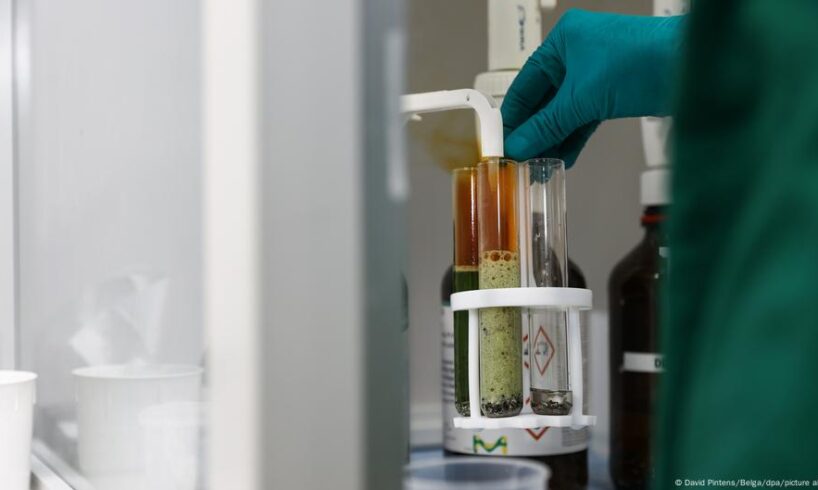
The sleepy small town of Trissino lies at the foot of the Italian Alps, surrounded by lush fields, green hills, and small industrial plants on its outskirts.
Though there is nothing to suggest that gigantic quantities of drinking water and large parts of the soil in the entire region have been contaminated with extremely toxic chemicalsfrom a local chemical facility. But that is what a court in Rome recently concluded.
In a case that opened in 2021, eleven defendants were sentenced to years in prison. They had worked for the Japanese Mitsubishi Group and Chemical Investors from Luxembourg, among others.
Forever chemicals can get into the body via drinking waterImage: ANP/Hollandse Hoogte/Jeffrey Groeneweg/IMAGO
According to estimates by non-governmental organizations, around 350,000 people in the northern Italian region of Veneto could be affected by the contamination.
What are forever chemicals?
Perfluorinated and polyfluorinated alkyl compounds, PFAS for short, are extremely persistent chemicals that cannot be broken down. Once they enter the environment, they remain there ‘forever’.
Scientists have established a link between PFAS and liver and kidney damage, increased cholesterol levels, diseases of the lymph nodes and reduced fertility in men and women. According to the German Federal Environment Agency, it also leads to low birth weights in babies, can reduce the effectiveness of vaccinations and cause cancer in high concentrations.
The chemicals are considered a global problem and can be detected almost everywhere.
In 2018, scientists at Harvard University found 98% of US citizens have PFAS in their blood. Studies on breast milk in countries such as India, Indonesia and the Philippines were able to detect the substances in almost all samples. In Germany, too, every child has forever chemicals in their bodies. A fifth of them exceed critical levels.
From the atom bomb to the plate
PFAS were discovered in 1938 by the American chemical giant DuPont. Due to their special properties of protecting metal from corrosion even at high temperatures, the chemicals were first used in the development of the atomic bomb.
PFAS were used in the development of the atomic bombImage: Ales Utouka/IMAGO
The substance later found its way into households around the world under the brand name “Teflon” in the form of coated pans. This marked the beginning of the commercial rise of the chemicals, which proved to be useful for many products.
With their unique resistance to heat, water and dirt, they are used in a wide range of consumer and industrial products. They can be found in everything from waterproof outdoor clothing, make-up and stain-resistant carpets to medical devices, semiconductors and wind turbines.
The chemicals, which are mainly ingested via drinking water and food, accumulate in the body over time. In addition to breast milk and blood, they can also be detected in hair.
Decades of concealing the danger
In 1998, the non-stick coating of “Teflon” was clearly scratched when a hundred cows belonging to a cattle farmer suddenly died near a production facility in the US city of Parkersburg in West Virginia.
It was later revealed that thousands of people in the region were contaminated by a leaking dump and wastewater from the DuPont factory that contained PFAS.
PFAS: The secret toxins in your body
To view this video please enable JavaScript, and consider upgrading to a web browser that supports HTML5 video
Documents show that DuPont, unlike government authorities, had known about the danger for decades but continued to discharge the substance into the environment. Studies suggest that high levels of PFOA (a specific PFAS substance) in the region are linked to cases of kidney and testicular cancer.
In 2017, DuPont and the now spun-off company Chemours agreed to pay a total of $671 million (€574 million) in compensation to 3,550 people affected.
Europe plans a phase out
PFAS are still being released into the environment. The US environmental organization EWG has calculated that almost 10,000 locations across America are contaminated with the substances. This is based on measurements by the US Environmental Protection Agency, among others. It is estimated that around 160 million people could be affected nationwide.
In Europe, 23,000 sites are known to be contaminated with PFAS. According to the European Environment Agency, 2,300 of these are so heavily contaminated that they pose a health risk.
In Alsace, France, the authorities are currently warning people not to drink tap water after checks revealed elevated levels of 20 forever chemicals.
A manufacturere in Dalton, which is sometimes referred to as the ‘carpet capital of the world’, is facing litigation over PFAS contaminationImage: Issam Ahmed/AFP
And in Dalton in the US state of Georgia, a lawsuit is currently being filed against a carpet manufacturer, Chemours and the chemical company 3M. Residents there also fear they have fallen ill due to PFAS contamination.
Legally binding limits for six PFAS chemicals in drinking water were adopted for the first time under former US President Joe Bide. The Trump administration has reversed four of them.
In 2023, the 3M Group agreed to pay around $10 billion to local water suppliers to settle lawsuits over PFAS pollution and those that could arise in the future. 3M is also being sued for contamination in the Netherlands, another country where it operates.
The European Union recently passed legislation aimed at reducing the use of these substances. In the long term, the member states are seeking to completely abolish PFAS. Exceptions are to be made for products whose use of PFAS is “essential for society”. This could include, for example, medical material such as stents for opening and closing blood vessels or artificial joints.
This article was originally published in German.
Are PFAS affecting you? What you should know
To play this audio please enable JavaScript, and consider upgrading to a web browser that supports HTML5 audio




